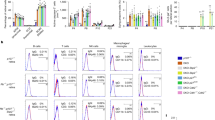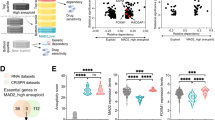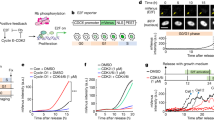Abstract
Advanced human cancers are invariably aneuploid, in that they harbour cells with abnormal chromosome numbers1,2. However, the molecular defects underlying this trait, and whether they are a cause or a consequence of the malignant phenotype, are not clear. Mutations that disable the retinoblastoma (Rb) pathway are also common in human cancers1. These mutations promote tumour development by deregulating the E2F family of transcription factors leading to uncontrolled cell cycle progression3. We show that the mitotic checkpoint protein Mad2 is a direct E2F target and, as a consequence, is aberrantly expressed in cells with Rb pathway defects. Concordantly, Mad2 is overexpressed in several tumour types, where it correlates with high E2F activity and poor patient prognosis. Generation of Rb pathway lesions in normal and transformed cells produces aberrant Mad2 expression and mitotic defects leading to aneuploidy, such that elevated Mad2 contributes directly to these defects. These results demonstrate how chromosome instability can arise as a by-product of defects in cell cycle control that compromise the accuracy of mitosis, and suggest a new model to explain the frequent appearance of aneuploidy in human cancer.
This is a preview of subscription content, access via your institution
Access options
Subscribe to this journal
Receive 51 print issues and online access
$199.00 per year
only $3.90 per issue
Buy this article
- Purchase on SpringerLink
- Instant access to full article PDF
Prices may be subject to local taxes which are calculated during checkout





Similar content being viewed by others
References
Hanahan, D. & Weinberg, R. A. The hallmarks of cancer. Cell 100, 57–70 (2000)
Albertson, D. G., Collins, C., McCormick, F. & Gray, J. W. Chromosome aberrations in solid tumors. Nature Genet. 34, 369–376 (2003)
Dyson, N. The regulation of E2F by pRB-family proteins. Genes Dev. 12, 2245–2262 (1998)
Jallepalli, P. V. & Lengauer, C. Chromosome segregation and cancer: cutting through the mystery. Nature Rev. Cancer 1, 109–117 (2001)
Cahill, D. P. et al. Mutations of mitotic checkpoint genes in human cancers. Nature 392, 300–303 (1998)
Cleveland, D. W., Mao, Y. & Sullivan, K. F. Centromeres and kinetochores: from epigenetics to mitotic checkpoint signaling. Cell 112, 407–421 (2003)
Yu, H. Regulation of APC-Cdc20 by the spindle checkpoint. Curr. Opin. Cell Biol. 14, 706–714 (2002)
Kalitsis, P., Earle, E., Fowler, K. J. & Choo, K. H. Bub3 gene disruption in mice reveals essential mitotic spindle checkpoint function during early embryogenesis. Genes Dev. 14, 2277–2282 (2000)
Dobles, M., Liberal, V., Scott, M. L., Benezra, R. & Sorger, P. K. Chromosome missegregation and apoptosis in mice lacking the mitotic checkpoint protein Mad2. Cell 101, 635–645 (2000)
Michel, L. S. et al. MAD2 haplo-insufficiency causes premature anaphase and chromosome instability in mammalian cells. Nature 409, 355–359 (2001)
Cahill, D. P. et al. Characterization of MAD2B and other mitotic spindle checkpoint genes. Genomics 58, 181–187 (1999)
Hernando, E. et al. Molecular analyses of the mitotic checkpoint components hsMAD2, hBUB1 and hBUB3 in human cancer. Int. J. Cancer 95, 223–227 (2001)
Wassmann, K. & Benezra, R. Mad2 transiently associates with an APC/p55Cdc complex during mitosis. Proc. Natl Acad. Sci. USA 95, 11193–11198 (1998)
Ren, B. et al. E2F integrates cell cycle progression with DNA repair, replication, and G(2)/M checkpoints. Genes Dev. 16, 245–256 (2002)
Nahlé, Z. et al. Direct coupling of the cell cycle and cell death machinery by E2F. Nature Cell Biol. 4, 859–864 (2002)
Narita, M. et al. Rb-mediated heterochromatin formation and silencing of E2F target genes during cellular senescence. Cell 113, 703–716 (2003)
Sanchez-Carbayo, M. et al. Molecular profiling of bladder cancer using cDNA microarrays: defining histogenesis and biological phenotypes. Cancer Res. 62, 6973–6980 (2002)
Arber, N. et al. Antisense to cyclin D1 inhibits the growth and tumorigenicity of human colon cancer cells. Cancer Res. 57, 1569–1574 (1997)
Dalbagni, G., Presti, J., Reuter, V., Fair, W. R. & Cordon-Cardo, C. Genetic alterations in bladder cancer. Lancet 324, 469–471 (1993)
Alaminos, M. et al. Genome-wide analysis of gene expression associated with MYCN in human neuroblastoma. Cancer Res. 63, 4538–4546 (2003)
Schuldiner, O. & Benvenisty, N. A DNA microarray screen for genes involved in c-MYC and N-MYC oncogenesis in human tumors. Oncogene 20, 4984–4994 (2001)
Van 't Veer, L. J. et al. Gene expression profiling predicts clinical outcome of breast cancer. Nature 415, 530–536 (2002)
Lentini, L., Pipitone, L. & Di Leonardo, D. Functional inactivation of pRB results in aneuploid mammalian cells after release from a mitotic block. Neoplasia 4, 380–387 (2002)
Spruck, C. H., Won, K. A. & Reed, S. I. Deregulated cyclin E induces chromosome instability. Nature 401, 297–300 (1999)
Okuda, M. et al. Nucleophosmin/B23 is a target of CDK2/cyclin E in centrosome duplication. Cell 103, 127–140 (2000)
Stemmann, O., Zou, H., Gerber, S. A., Gygi, S. P. & Kirschner, M. W. Dual inhibition of sister chromatid separation at metaphase. Cell 107, 715–726 (2001)
Michel, L. et al. Complete loss of the tumor suppressor MAD2 causes premature cyclin B degradation and mitotic failure in human somatic cells. Proc. Natl Acad. Sci. USA 101, 4459–4464 (2004)
Zou, H., McGarry, T. J., Bernal, T. & Kirschner, M. W. Identification of a vertebrate sister-chromatid separation inhibitor involved in transformation and tumorigenesis. Science 285, 418–422 (1999)
Lanni, J. S. & Jacks, T. Characterization of the p53-dependent postmitotic checkpoint following spindle disruption. Mol. Cell. Biol. 18, 1055–1064 (1998)
Darzynkiewicz, Z., Gong, J., Juan, G., Ardelt, B. & Traganos, F. Cytometry of cyclin proteins. Cytometry 25, 1–13 (1996)
Acknowledgements
We thank M. Narita for providing the shRb construct, M. Lu for the bladder tissue microarray, S. Menendez for technical assistance and A. Kel for the use of the SiteScan program. We thank the Molecular Cytology and the Flow Cytometry Core Laboratories at Memorial Sloan-Kettering and P. McCloskey from CSHL flow cytometry facility for technical assistance. Also, we thank S. Gangadharan, R. Dickins, S. Gonzalez, N. Abumrad, B. Stillman and P. P. Pandolfi for reading the manuscript. We also thank all the members of the Lowe and Cordon-Cardo laboratories for discussions. This work was supported by program project grants from the NCI (S.W.L. and C.C.C.), Clinical Investigator Research Development Awards (L.M. and R.B.), DOD-Breast Cancer Research Program fellowship award (Z.N.), a Fundacion Caja Madrid-CNIO-MSKCC fellowship (E.H. and M.A.), a Fellowship from the Spanish Ministry of Education, Culture and Sports (E.D.R.), a US NCI postdoctoral training grant (M.T.H.) and gifts from the Laurie Strauss Leukemia Foundation and the Herbert J. Siegel philanthropic fund.
Author information
Authors and Affiliations
Corresponding author
Ethics declarations
Competing interests
The authors declare that they have no competing financial interests.
Supplementary information
Supplementary Figure S1
a, Schematic diagrams of the MAD2L1 and Cyclin A (CCNA) promoter regions, indicating the theoretical E2F binding sites (black boxes). b, Table containing the nucleotide sequence and location of the predicted E2F binding sites in the Mad2 promoter (PDF 48 kb)
Supplementary Figure S2
Immunohistochemistry of Mad2 and Ki-67 in highly proliferating organs (a), and in some transitional cell carcinomas of the bladder (b), illustrating that Mad2 expression is low or negative in some proliferative tissues - it is not simply a proliferation marker (PDF 1618 kb)
Supplementary Figure S3
a, Mad2 immunofluorescence staining (FITC) of Mad2-transduced IMR90 fibroblasts, showing a highly positive multinucleated cell. b, g-tubulin staining (FITC) in Mad2- and vector-infected IMR90 cells, demonstrating that Mad2-transduced cells don’t display major centrosomal amplification (PDF 1588 kb)
Supplementary Figure S4
a, Table containing the average time required to complete two defined mitotic stages in vector, shRB, E1A, and Mad2 transduced cells. Western Blot analyses of cyclin B1 (cycB) (b) and securin/Pds1 (c) in HCT116 and IMR90, released after a double thymidine blockade, showing that cyclin B and securin degradation are delayed in shRb, E1A or Mad2 transduced cells. d, Western blot for E2F and E1A in HCT116 cells ectopically expressing E2F, E1A or a vector control together with either a Mad2 hairpin (sh-Mad2) or a hairpin control (sh-con). E1A or E2F levels are not altered in the presence of shMad2 (PDF 156 kb)
Supplementary Video A
Normal cell division in vector-transduced NIH-3T3 cells by phase-contrast. (MOV 3133 kb)
Supplementary Video B
Normal chromosomal segregation in vector-transduced NIH-3T3 cells by green fluorescence. (MOV 272 kb)
Supplementary Video C
Prolonged or failed cytokinesis in 3T3 cells transduced with shRb. (MP4 231 kb)
Supplementary Video D
Prolonged chromosome segregation due to a cytokinesis problem in 3T3 cells transduced with shRb. (MP4 103 kb)
Supplementary Video E
Cytokinesis failure in Mad2-transduced 3T3 cells. (MP4 605 kb)
Supplementary Video F
Cytokinesis failure followed by reattachment and multinucleation in a Mad2-transduced 3T3 (MP4 309 kb)
Supplementary Video G
Small fragment of DNA material lost during chromosome segregation in an E1A-expressing NIH-3T3 cell . (MOV 381 kb)
Supplementary Video H
Asymmetrical chromosome segregation in Mad2-transduced 3T3 cells. (MOV 808 kb)
Supplementary Video I
Problems in chromosome alignment followed by abnormal segregation in shRb-expressing HCT116 cells. (MOV 631 kb)
Supplementary Video J
Chromosomes pulling towards the poles of the spindle for a prolonged period of time, ending in a completely aberrant segregation. Mad2-transduced HCT116 cells. (MOV 972 kb)
Rights and permissions
About this article
Cite this article
Hernando, E., Nahlé, Z., Juan, G. et al. Rb inactivation promotes genomic instability by uncoupling cell cycle progression from mitotic control. Nature 430, 797–802 (2004). https://doi.org/10.1038/nature02820
Received:
Accepted:
Issue date:
DOI: https://doi.org/10.1038/nature02820
This article is cited by
-
Chronic spindle assembly checkpoint activation causes myelosuppression and gastrointestinal atrophy
EMBO Reports (2024)
-
The promoting effect and mechanism of MAD2L2 on stemness maintenance and malignant progression in glioma
Journal of Translational Medicine (2023)
-
Proteogenomics of different urothelial bladder cancer stages reveals distinct molecular features for papillary cancer and carcinoma in situ
Nature Communications (2023)
-
Prognostic analysis of E2F transcription factors E2F1 and E2F3 in four independent pediatric neuroblastoma cohorts
BMC Pediatrics (2022)
-
Interruption of aberrant chromatin looping is required for regenerating RB1 function and suppressing tumorigenesis
Communications Biology (2022)



